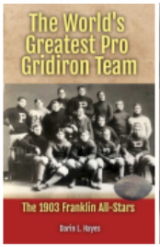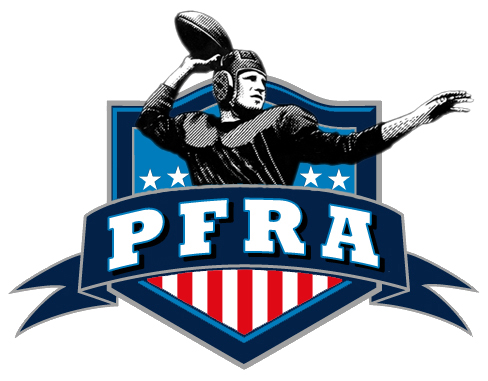It had to get boring playing football in California in the early Nineties, the 1890s, that is. Teams such as Cal and Stanford had few teams to play unless they or someone else spent the Christmas season traveling and playing football. Cal, for example, played nineteen games from the fall of 1892 through 1895. They played: — www.footballarchaeology.com
Timothy P. Brown joins us on the discussion to explain why we read of the coaching exploits of Walter Camp in California.
This conversation is based on Tim's original Tidbit titled:
Walter Camp's California Adventures.
-
Transcribed Chat Walter Camp Going to California with Timothy Brown
Hello, my football friends. This is Darin Hayes of PigskinDispatch.com. Welcome once again to The Pig Pen, your portal to positive football history. And we are in Tuesday mode again.
Starting off this new year right, we have Timothy P. Brown of
Football Archaeology joining us to talk about another exciting tidbit that he's had come out recently. Tim, welcome back to The Pig Pen. Hey, Darren.
Thank you. Thank you. I hope you had a great holiday.
I certainly did and planning to enjoy them some more. Yeah, it's, you know, football season is still going on here. Just got done with the bowl games and now we're getting ready for playoffs in the professional level.
So, we have some great football history to talk about all month long and all year long. And we're glad that you're here to be a part of it. A great subject that we're going to talk about tonight, Tim, that comes from one of your October tidbits.
A little bit on the founder and father of modern football, Walter Camp, sounds like a very interesting topic. Yeah. So, I mean, obviously, anytime you can pull Walter Camp into a conversation, you're probably on pretty solid ground.
But, you know, I think that the thing that I enjoyed about this particular, that particular tidbit is really just kind of, you know, if you just step back and think about what the world was like and what California was like back in the 1890s when he, you know, he had been coaching, advising, you know, with Yale. And then kind of stepped away a bit, still did a lot of the executive management stuff for, you know, for the Yale Athletic Association. But, you know, he had a company to run, and the New Haven Clock Company was his family company, so he's doing all that.
But he still, you know, kind of got the call from people out at Stanford. They wanted him to come on out and teach him a thing or two about football, you know. And it's just, you know, you kind of have to step back then because I think the Intercontinental Railroad was, you know, not that old by the time, you know, by, say, 1892.
So, here's this guy in Connecticut traveling all the way across the country and, you know, brought his wife along, but still, you know, he's, at that time, it had to be a week-long trip, you know, on the railroad just to cross the country. If it's anything I know from a lot of the Rose Bowl teams that were going out there from the East Coast, like New York City, when Columbia went, it was a six-day trip. So, I assume that's got to be pretty close to what Camp was traveling.
Yeah. And I'm more, you know, I'm maybe more knowledgeable about some of the Midwestern teams, but they were, you know, four and five-day trips, you know, and this is in the 20s, you know, or in the late teens, you know, that time period. So, you know, I mean, he was out there early on because people were still sailing, you know, from the East Coast to the West Coast.
And that was, and that's no Panama Canal. That's right. So, they're going a long way.
But anyway, so he goes out there, and there had been a series of other, you know, recent graduates. So, somebody, you know, who was just a year or two out of school, who had gone out to the West Coast to help, you know, teach football and help them, you know, kind of get up to speed. And so, you know, despite all that distance, one of the things that strike me is just how often, I mean, I know, you know, I did an article on shoulder pads recently, and, you know, they showed up at Yale in like, whatever it was, 1888 or something, that kind of time frame.
And sure enough, like a year later, the guys at Cal and Stanford are wearing them, you know. So, pretty much everything transferred, but, you know, it required some messengers. And so, he becomes a messenger.
And he went out there in 1892, and then in 93 and 95 as well, you know, sometimes arriving, you know, after the Yale season was over. But in California, they played a lot later. You know, they didn't necessarily play in September.
You know, they'd take a game if they got one. So, a lot of times, they played a little bit later, so he could be there for, you know, most of the season. But the other thing, really, that's striking, I just think, is that, you know, there just weren't that many teams to play.
You know, part of the point about the article is they end up playing like, you know, two pretty famous teams in the Bay Area. One was the San Francisco Olympic Club. They, you know, like a lot of these athletic clubs, they had, you know, pretty strong teams.
Reliance Athletic Club was the other one. But, like, they played, those guys, like, one of the years, Cal played one of them two times; the other one, it was a reverse for Stanford. And there just weren't that many other teams.
You know, I mean, you could go down to LA, which was a trip, and Stanford did that over the holidays once or twice. And you could go to the Northwest to play somebody in Portland. But otherwise, you know, I mean, really, even in the 20s, the West Coast, the teams that we think of as the top teams on the West Coast now, they were still playing like, you know, the USS Pennsylvania and, you know, battleships moored in port.
You know, they'd have their teams, and so they play them in their early in the season. They play Chemiwa and Sherman, which are both, you know, Native American schools. Even like Arizona, you know, I mean, those schools were pretty dinky.
There just weren't many people living in Arizona, you know, back then. So pretty dinky schools, and, you know, they would play like the Occidentals of the world and, you know, that kind of thing. And then, you know, I think we talked about it before, but USC didn't become a big deal until the 20s, you know.
So anyways, you know, he's going out there, and basically, there are two schools of any note on the West Coast, Cal and Stanford. They're rivals, and, you know, they kind of try to knock each other off in the big game. But, you know, it's just kind of an interesting story how knowledge of football disseminated from these guys who had just played in the previous years with, you know, Stanford, or not Stanford, but, you know, Harvard, Yale, Princeton.
And then you get Walter Camp, of all people, to head out there and, you know, try to show him a few things. And, you know, he seems to have been reasonably successful, you know. And anyway, it just, I don't know, it's just, it's like a time capsule for me.
It's just a strange period. There must have been some kind of a pipeline going from the East, like the Yales and Harvards, out to California. I remember there's a story somewhere that I read about Leland being the coach at Harvard.
And he was; I think he was bringing in the wedge designed for kickoff or something. He was going to spring it on Yale as a surprise. They were practicing in secret and everything.
He also said something to somebody who had traveled out to California. This person went out there and casually talked about it at some restaurant. And somebody from Yale overheard them, telegraphed back to Camp, and said, hey, this is what they're planning to do.
And, of course, Camp had the answer for doing it. And so Harvard was the one in surprise. The trap that wasn't set on Yale was set on Harvard.
So, yeah. Yeah. Yeah.
No, I recall the story. I hadn't, you know, thought about it in that context, but yeah, it's a perfect fit. You know, it's really, I mean, just amazing the, you know, just the difference in time.
And yet, you know, they're still, they're playing this game that, you know, we still play today, you know, just a little bit different conditions, but, you know, like UCLA, you know, was a normal school, you know, back in the 1890s. So, you know, they really didn't really become big time until the thirties, maybe even, you know, maybe even the forties, but, you know, when they had the, you know, like Robinson and some of those guys in the late thirties, you know, they were certainly. Yeah.
It's just surprising how fast it spread. Cause I know we've talked about it a few times where, when a university of Chicago started taking shape with Amos Alonzo Stagg coming from the East, you know, that was the far West. And, you know, we got to go all the way to Chicago to play these teams, you know, another, what, 1500 miles to the West coast from there, or maybe it's 2000 miles, I'm not sure, distance.
And, you know, just a few years later, they're starting to become power. So very interesting. Yeah.
Yeah. I mean, you know, there was, whenever anybody wrote, you know, really till probably World War I, you know, most time, they're saying, well, the football out West that meant Midwest, you know, and otherwise they didn't sort of far, the far West or the Pacific coast or something like that. But West, you know, I mean, the big 10 was the Western Conference.
So, you know, that kind of gives you a sense. And even like those silly boys from Michigan, they still, you know, sing about being the champions of the West. Right.
Right. That's it. It's in their song, right? Yeah.
Yeah. So, wow. So I was here most of the time, but nevertheless.
Hey, it's all good. It's all good. Yeah.
So, hey, well, we appreciate you. You're bringing this as another great, a little bit of a football history. And we just love hearing these tidbits and reading about them each and every day.
And once you share with the listeners where they too can learn about your tidbits each and every day. Yeah. So, you know, there's two ways.
The best way is to just find footballarchaeology.com and subscribe. It's free to subscribe. There are paid versions.
Most of that helps me buy stuff that I show, you know, either books or postcards or whatever it may be. So help support Tim's habits. Yes.
Please support my habits. And then, you know, I also, at the current time, I'm still tweeting out that stuff every day. And it's, you know, that's become such a mess there that I'm not sure how much longer I'll do it, but we'll see.
You know, as long as I'm getting some reaction from people on Twitter, then I'll do it, I guess. But anyways, best way and to make sure you don't miss anything, join or subscribe, and then you'll get an email every day. Every time I tweet or post anything, you get an email about it and read them if you want, delete them if you want.
Yep. They're always good reading and they don't take very long to do. Usually 20 seconds to a minute probably.
And I usually find myself engrossed in whatever image you have included in it. And that's what I spend most of my time looking at because I know that's sort of where you usually center your ideas from finding an image. That's what we're talking about, these habits that Tim's buying.
He's buying, you know, postcards and books and old programs and finding photographs and just finding little hidden gems in there that I would overlook, and probably most people would, but Tim finds them and brings up some great football attributes, a football history to it. So, we really appreciate that. Well, it's fun.
It's fun, but yeah, join up if you're interested. Otherwise, keep listening to these as well. So.
Yeah. Tim's taken Where's Waldo to a whole new level, looking for the football history in this photograph. So, Tim, thanks a lot for joining us, and we'll talk to you again next week.
Hey, very good. Thank you.
Transcribed by TurboScribe.ai.










